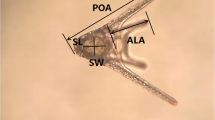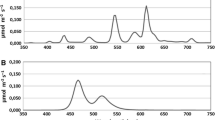Abstract
The rate of development and degree of survival of Asellus aquaticus eggs outside the marsupium of ovigerous females are affected by water quality and temperature. Eggs were maintained in polluted river water and relatively clean canal water. Developmental rates increase with increased temperature, but survival decreases. Eggs from polluted site ovigerous females survive better in clean water than in polluted water. Eggs from clean site ovigerous females maintained in polluted water have significantly lower survival rates than eggs from the polluted site at all temperatures tested. The developmental rate of clean site eggs is increased significantly in polluted water at 10–25 °C, possibly as a response to the stress imposed upon them.
It is suggested that the method outlined might form the basis of a useful bioassay technique for measuring water quality.
Similar content being viewed by others
References
Adcock, J. A., 1979. Energetics of a population of the isopod Asellus aquaticus: Life history and production. Freshwater Biology, 9: 343–355.
Adema, D. M. M., 1978. Daphnia magna as test organism in acute and chronic toxicity experiments. Hydrobiologia, 59: 125–134.
Andersson, E., 1969. Life-cycle and growth of Asellus aquaticus (L.) with special reference to the effects of temperature. Institute of Freshwater Research, Drottningholm, Rept. No. 49: 5–26.
Aston, R. J. & Milner, A. G. P., 1980. A comparison of populations of the isopod Asellus aquaticus above and below power stations in organically polluted reaches of the River Trent. Freshwater Biology, 10: 1–14.
Beneden, E. Van, 1869. Recherches sur l'embryogénie des Crustacés — 1. Observations sur le développement de l'Asellus aquaticus. Bull. Acad. r. Belg., 2nd Ser., 28: 54–87.
Berglund, T., 1968. The influence of predation by the brown trout on Asellus in a pond. Institute of Freshwater Research, Drottningholm, Rept. No. 48: 77–101.
Birstein, Ya. A., 1964. Freshwater isopods(Asellota). In: Fauna of U.S.S.R. (eds E. N. Pavlouskii & A. A. Shtakel'berg), Crustacea Vol. III, No. 5. Zoological Institute of the Academy of Sciences of the U.S.S.R. New Series No. 47, 148 pp. Israel Program for Scientific Translations, Jerusalem.
Bryce, D., Caffoor, I. M., Dale, C. R. & Jarrett, A. F., 1978. Macro-invertebrates and the bioassay of water quality, a report based on a survey of the River Lee. Nelpress, 30 pp.
Canton, J. H. & Adema, D. M. M., 1978. Reproducibility of short-term and reproduction toxicity experiments with Daphnia magna and comparison of the sensitivity of Daphnia magna with Daphnia pulex and Daphnia cucullata in short-term experiments. Hydrobiologia, 52: 135–140.
Conner, P. M., 1972. Acute toxicity of heavy metals in some marine larvae. Mar. Poll. Bull., 3: 190–192.
Dejdar, E., 1930. Die Funktion der ‘blattöformigen Anhänge’ der Embryonen von Asellus aquaticus (L.). Z. Morph. Ökol. Tierre, Berlin, 19: 321–329.
Ellis, R. J., 1972. A life history study of Asellus intermedius Forbes. Trans. Amer. Microsc. Soc., 80: 80–102.
Gledhill, T., Sutcliffe, D. W. & Williams, W. D., 1976. Key to British Freshwater Crustacea: Malacostraca. Freshwater Biological Association, Scientific Publications, 32: 1–71.
Hawkes, H. A. & Davies, L. J., 1974. Some effects of organic enrichment on benthic invertebrate communities in stream riffles. In: The scientific management of animal and plant communities for conservation (eds E. Duffy & A. J. Watt), 11th Symposium of the British Ecological Society 1970: 271–293.
Helawell, J. M., 1978. Biological surveillance of rivers. Water Research Centre, Stevenage and Medmenham, 332 pp.
Holdich, D. M., 1968. Reproduction, growth and bionomics of Dynamene bidentata (Crustacea: Isopoda). J. Zool., Lond., 156: 137–153.
Holland, D. G., 1976. The distribution of the freshwater Malacostraca in the area of the Mersey and Weaver River Authority. Freshwater Biology, 6: 265–276.
Holland, G. J., 1956. The eradication of Asellus aquaticus from water supply mains. J. Inst. Wat. Ent., 10: 221–241.
Hynes, H. B. N., 1960. The biology of polluted waters. Liverpool University Press, 202 pp.
Jensen, K., 1975. Hatching rate as bioassay. Proposal for a standard technique. Bull. Environ. Contam. Toxicol., 14: 562–564.
Kaestner, A., 1970. Invertebrate Zoology, Vol. III, Crustacea. Interscience Publishers, 523 pp.
Lockwood, A. P. M., 1976. Effects of pollutants on aquatic organisms. Cambridge University Press, 193 pp.
Marcus, J. H. & Willoughby, L. G., 1978. Fungi as food for the aquatic invertebrate Asellus aquaticus. Trans. Br. Mycol. Soc., 70: 143–146.
McCormack, J. C. & Le Cren, D. 1971. Thirty years of perch investigations in Windermere. Proc. of the 5th British Coarse Fish Conference 1971: 104–108.
McMurrich, J. P., 1895. Embryology of the isopod Crustacea. J. Morph., 11: 63–154.
Rossi, L. & Fano, A. E., 1979. Role of fungi in the trophic niche of the congeneric detrivorous Asellus aquaticus and A. coxalis (Isopoda). Oikos, 32: 380–385.
Rossi, L., Manassero, A. & Vitagliano-Tadini, G. 1975. Cure parentali ‘marsupiali’ in Asellus aquaticus (L.) (Crust. Isop.). Rend. Acc. Naz. Lincei, 58: 433–440.
Saliba, L. J. & Krzyz, R. M., 1976. Effect of heavy metals on hatching of brineshrimp eggs. Mar. Poll. Bull., 7: 181–182.
Stebbing, A. R. D., 1979. An experimental approach to the determinants of biological water quality. Phil. Trans. R. Soc. Lond., B. 286: 465–481.
Steel, E. A., 1961. Some observations on the life history of Asellus aquaticus and Asellus meridianus Racovitza (Crustacea: Isopoda). J. Zool., Lond., 137: 71–87.
Severn Trent Water Authority, 1979. Water Quality 1977/78. Birmingham, 203 pp.
Vitagliano-Tadini, G. & Valentino, F., 1964. Reproductive cycle in various stocks of Asellus aquaticus of different geographical origin. Rivista di Biologia, 57: 347–358.
Vernberg, F. J. & Vernberg, W. B., 1974. Pollution and physiology of marine organisms. Academic Press, 492 pp.
Vernberg, F. J., Calabrese, A., Thurberg, F. P. & Vernberg, W. B., 1977. Physiological responses of marine biota to pollutants. Academic Press, 462 pp.
Woodiwiss, F. S., 1964. The biological system of stream classification used by Trent River Board. Chemistry and Industry, 11: 443–447.
Author information
Authors and Affiliations
Rights and permissions
About this article
Cite this article
Holdich, D.M., Tolba, M.R. The effect of temperature and water quality on the in vitro development and survival of Asellus aquaticus (Crustacea: Isopoda) eggs. Hydrobiologia 78, 227–236 (1981). https://doi.org/10.1007/BF00008519
Received:
Issue Date:
DOI: https://doi.org/10.1007/BF00008519




